Hi everyone, I’m starting the week being with family in Grants Pass (southern Oregon) today and tomorrow so this roundup will be a bit quick and short. I won’t be back in the Shed until Tuesday night, so please adjust your expectations as we settle into the week.
Here are the most notable items our community came across in the past seven days:
Pedestrian-less in Seattle: ” If I paid attention to drivers as well as they paid attention to me, I’d be dead by now.” (Seattle Times Opinion)
Feeling validated: I’ve long pointed to how the decline in cycling in Portland has tracked with the increase in road fatalities. Now there’s research that might back that up. It shows that in cities with high cycling rates, traffic safety for all users is generally better. (Journal of Cycling and Micromobility Research)
Heavy Lyft: Los Angeles officials have run into opposition for efforts to expand e-bike share because of the labor practices of its preferred vendor: Lyft. (Politico)
Fountain of youth: We’re used to articles that extol the health virtues of cycling, but this one is different. It’s about how our society discourages women from getting into pursuits like cycling, and how revelatory pedaling can be for them — even well after retirement age. (NY Times Opinion)
Speed cameras all the rage: It says a lot about the intractable behavior of most drivers that a country where “Freedom!” is such a cherished value has given into automated speed cameras. (NPR)
Bikers, beware: Florida is a beautiful place, unfortunately it’s way too deadly for bicycle riders says this new report that ranks American counties. (Guardian)
How to talk about it: Get personal, stop blaming individuals, include a call-to-action — those are the three big takeaways from a report on how to message Vision Zero/Safe Systems effectively. (Streetsblog USA)
Use bike racks to protect sidewalks: We don’t have a huge problem with people parking on sidewalks, but this campaign from the UK could still be used here to keep people from driving up on them. (Road.cc)
Land use for the (climate change) win: Statewide laws that encourage compact development could be an even more powerful lever in climate change policymaking. (Rocky Mountain Institute)
Sec Pete visits the bridge: A big push from Democrats to create momentum for funding the Interstate Bridge Replacement project brought US DOT Sec. Pete Buttigieg to town. (OR Capital Chronicle)
Thanks to everyone who sent in links this week. The Monday Roundup is a community effort, so please feel free to send us any great stories you come across.


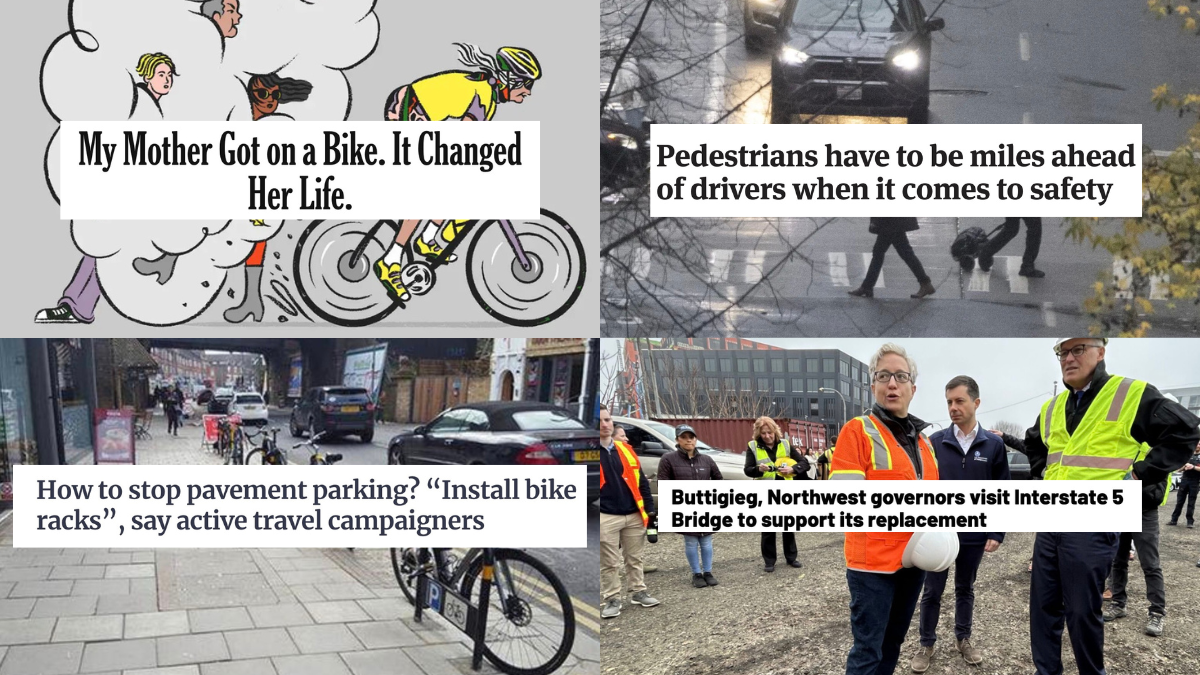
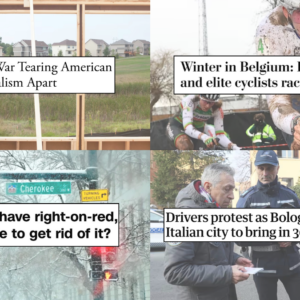
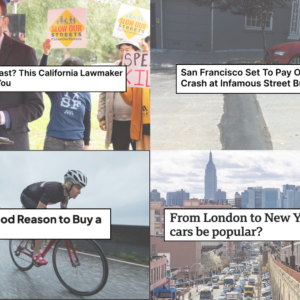
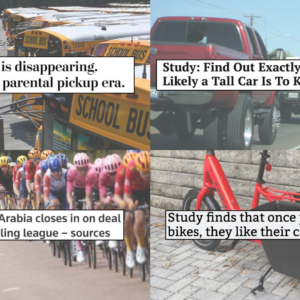
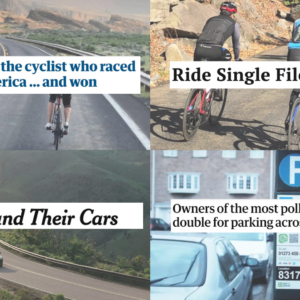
Thanks for reading.
BikePortland has served this community with independent community journalism since 2005. We rely on subscriptions from readers like you to survive. Your financial support is vital in keeping this valuable resource alive and well.
Please subscribe today to strengthen and expand our work.
Feeling Validated: The term “peer cities” and studying only 14 cities total (out of hundreds available) doesn’t inspire much confidence in the results, particularly when Boulder CO is one of those cities. On the other hand, it did inspire me to look up NJTransit along the way, the state-run transit agency, one of many states with their own public transit agencies (others include CT, VA, NC, and more).
On another tangent, the same journal had an interesting article on a tool for identifying optimal future bike lane links in Atlanta GA, which given our limited advocacy capacity, it’s helpful to pick our fights more efficiently.
https://www.sciencedirect.com/science/article/pii/S2950105924000068
Feeling validated: we need a new transportation planning term for the opposite of “safety in numbers”…
Isolated, at-risk.
Exposed.
Picked off from the herd.
Bold
Brave
Eccentric
Pilot Study
Test Case
Under Review
Not Yet MUTCD-Approved
Trump-Endorsed
Irreproducable
Unique
The Upper 1% of the Top 1%
One in a Million
Did you use a thesaurus page for a rolling paper?
Yes, my good ol’ NACTO Guide to Urban Planning Jargon, 293rd edition – it’s a great bathroom reader!
Re: Fountain of youth. I often take my partner on rides out to Gresham’s Farmer’s Market using Springwater. About a 15 mile round trip. The issue is we’re both pushing 70 and she doesn’t feel safe riding through east Portland to get to the Springwater. We manage, but wouldn’t it be nice to ride a Greenway to get to the Springwater? Wouldn’t it be nice to ride the other MUP’s in east Portland with the same comfort?
I ride the I205 MUP occasionally to see what condition it’s in and still won’t take my partner there for a ride.
It’s unfortunate that the best places to ride in east Portland are still scary to ride and only the bold ride them after dark. I205 is the only lighted MUP in the city thanks to ODOT. I84 is loud, but lighted for most of the MUP.
What is causing the continuing decline in cycling in Portland?
I lived in EP for 8+ years and other Parts of Portland for 9 previous years, often passing through EP to get to Gresham. The amount of trash and homelessness in EP seems to go through cycles, but EP being ugly and a bit run down is part of its charm – it is reflective of the rest of the USA, unlike “weird” inner Portland which reminds me of the university towns I used to live in – somewhat sanitized versions of the USA that’s good for tourism and films, but devoid of any character. I left EP because I could no longer afford to live there.
We all of us are imperfect, as are the communities we live in, so we must all learn “tolerance, forbearance, and neighborly love” towards each other and towards our various communities, people, and physical spaces.
# People who worked from home or formerly worked from home stopped cycling for transportation and became accustomed to using their SUVs for transportation.
# The large increase in aggressive driving and speeding during the pandemic continues to discourage many from cycling.
# Many cycling routes are defective, substandard, ill-maintained and/or in terrible state of repair.
# Lack of enforcement of cycling route priority results in chronic blockages due to construction, repairs, delivery, parking.
# The increase in negative messaging about cycling safety from transportation advocates and driving-centric interests.
# The City of Portland and PBOT have de-prioritized mode-share shift and transportation cycling. More recently this has included overt anti-cycling policy (e.g. removal of bike lanes, proposed removal of bike lanes, chronic delays in build-out of funded cycling facilities, cancelled or down-scaled cycling projects).
# Cycling is a fashion like any other and has a cyclical cultural popularity that’s currently at a low point
It’s likely an All Of The Above type situation. The decline in riding started long before covid and coincided with (but was probably not caused by) a rapid improvement in cycling infrastructure.
# Youth have social lives that are more “online” than previous generations so the utility of inexpensive transportation has decreased. A corollary of this trend, is that because many youth make fewer trips they can afford more SUV-centric options (e.g. Uber and Lyft).
The interesting thing was Buttieg talking about what a disaster it would be if the bridge were closed. Some of us remember the bridge was closed 20+ years ago with those same predictions of pending catastrophe. People adapted and nothing happened. There were some extra trains from Clark County and other efforts to mitigate. And it was temporary. But nonetheless it showed the region could survive without the bridge. Buttieg is just repeating the same plausible theoretical hypothesis that actual experience has proven wrong in the past.
The bridge does need to be replaced. But the only reason it hasn’t been is that every effort to replace it is immediately hijacked to add capacity to the freeway. And that will just increase traffic on Portland streets, creating worse traffic jams all over the place. The reality is when the bottle is full, putting a larger neck on it serves no purpose. Lots of people in Portland understand that, oppose the plan and the result is nothing gets done. Wash and repeat.
Early on in the CRC#1 process, there was a $100 million estimate to upgrade the foundations of the existing pair of bridges to survive a major earthquake – apparently perfectly doable according to federal officials at the time and likely still doable. But of course no one likes the looks of the old bridges, and the project is too cheap, and it won’t get so-and-so re-elected, and so on.
They spent over $100 million just on planning for the failed CRC#1 project and already far more than that for the new CRC project. Go figure.
Appears to be closer to $200 million. https://www.columbian.com/news/2014/apr/17/records-detail-spending-on-crc/
ROSS, yes you have a good memory…I just missed that 1997 event (aka Trunnion Repair project #1, not the #2 in 2020), but I did work for a department that was planning for the worst. Yes, other than the extra Amtrak trips added (today there is ‘no extra’ capacity per BNSF to do it again) and trucks used I-205 the big thing was the time of the year: a lot of folks took some vacation time then AND the DOTs were able to do the repair much quicker than expected (only 1 week in September).
https://www.worldtransitresearch.info/research/1624/
Also, only the older bridge was shut down. The newer bridge was temporarily re-striped for two-way travel. ODOT started a year in advance, with billboards and advertising to “take your vacation during (dates)” and worked with area businesses to promote that as well. It was also the first time ODOT used bonuses for the contractor if they finished early.